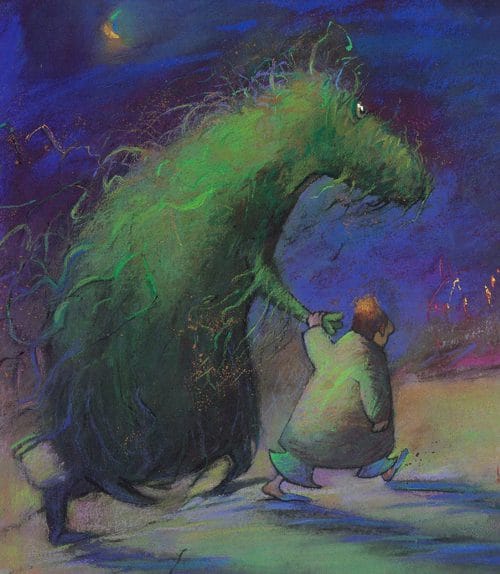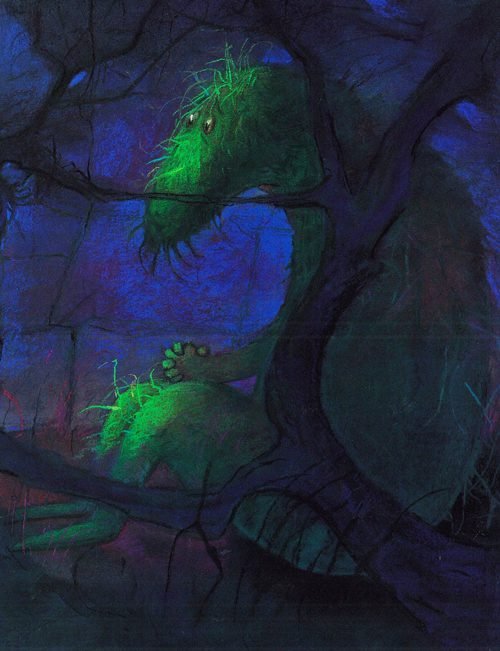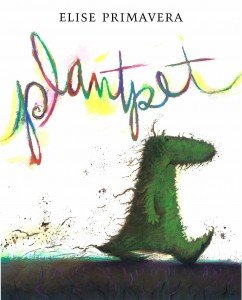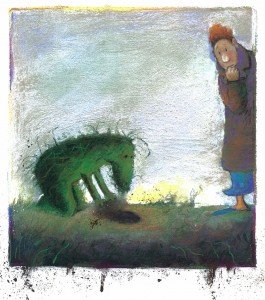I have a fern that is about 15 years old. Maybe 20. It’s not particularly attractive, at least in comparison to my other plants, and because it is rarely moved, the plant is lopsided; lush on one side (the public side) and bald on the other. I’ve named it Sideshow Bob because it sprouts dreads like Krusty’s infamous sidekick on the Simpson’s, but unlike the cartoon character, my Sideshow Bob possesses few, if any, homicidal inclinations. I should have turfed this plant a long time ago, but I have grown rather fond of ol’ Bob. My point? Anything can engender love — including plants, and books about plants.
From the moment I first laid eyes on the dirt-trailing, long-snouted stump of green foliage walking across the cover of Plantpet, I was in love. Like Bertie, the solitary, never-out-of-his-slippers human with the Don King hair in Elise Primavera’s story of unexpected friendship, I could not resist the charm of this tiny sprout, abandoned in a cage amongst Bertie’s junk. But is it a plant, or a pet? And is there a name (or treatment) for this type of love?
Luckily, the plant comes with instructions: ‘Turn this cage daily.” Bertie obliges, and the diminutive plant responds expeditiously, unfurling and growing until one day, it just walks out of the cage and straight into the long-neglected garden, where it starts to dig. Bertie joins the plant, and soon the garden is transformed into a blooming paradise. The two fall into a happy and amiable routine, with just one, troubling problem: Plantpet won’t stop digging. In fact, he insists on digging long after the need for holes has expired.
“Bad boy! No dig hole! Hole bad!” Bertie shouts, but Plantpet doesn’t understand. He can’t stop himself. Feeling frustrated, Bertie leads Plantpet to the farthest corner of the garden.

“Stay.”
This is where my heart begins to beat out of my chest. I’ve read the book many times, and this section never fails to destroy me. I feel so bad for Plantpet. He means no harm, and Bertie knows he means no harm, but what can he do?
Primavera’s illustration of Plantpet being led away is just gut-wrenching, as is the following page where Plantpet sits alone among the trees, his hands clasped together in the pose of a remorseful, frightened child. It’s an achingly beautiful painting. Downright haunting in fact, the melancholic mood deepened by the dark and heavily saturated colours. And yet…it is also charming, and maybe even a little funny — a giant, disheveled creature with plaintive, puppy-dog eyes, banished to the ‘penalty box’ for unsolicited digging. Of course, it doesn’t last long. Thank god, because I don’t think my heart could stand a prolonged estrangement.

Bertie continues to work in his garden for awhile, but it’s just not the same without Plantpet. Racing to the farthest corner of the garden to retrieve his pal, he finds a shriveled and parched Plantpet. Bertie gently picks up his friend and takes him home. This time, it’s Bertie who digs a hole.
“Here’s some warm dirt for your toes. And here’s a drink of water.”
And then…Bertie realizes what Plantpet had been trying to do all along — plant himself! With a hole big enough to stretch his roots and Bertie, ever-ready with the watering can, Plantpet becomes what he was meant to be — a tree, albeit one with an admirably long snout and a tangle of colourful branches. The story resolves with the budding horticulturalist and the fantastically endearing Plantpet in affable companionship.
Rarely has a book affected me at such a deep, emotional level, but perhaps I was predisposed to feel this way about a plant.
Certainly the illustrations by Elise Primavera contribute mightily to poignancy of Plantpet. In fact, the gorgeous artwork and sweetly amusing characterizations of Bertie and Plantpet provide most of the narrative in this sparsely worded picture book. The languid messiness of pastel and coloured pencil is the perfect medium for this plant and bachelor-based story. Although Primavera’s style varies from book to book, the looseness of the illustrations in Plantpet is reminiscent of Stephen Gammell’s work, to whom this book is dedicated.

Home Sweet Home
Elise Primavera is a New Jersey artist and author, who began her career as a fashion illustrator before moving on to loveable plants and many other equally loveable children’s books, including Auntie Claus, the Gumm Street Girl Stories, and another favourite of mine, Jack, Skinny Bones, and the Golden Pancakes. Sadly, Plantpet is out of print. My copy was nearly out of print too, the victim of an exploding bottle of tonic water, which sprayed an entire row books and in the process, nearly removed my head from my shoulders. Like the ‘real’ Plantpet, I was able to rehabilitate Plantpet, in spite of a few stains and crinkles in the dust jacket. No matter. Some things are just loveable, regardless of their eccentricities.
Just One More Book has a great interview with Ms Primavera on their blog, which you can listen to here.
Plantpet by Elise Primavera, G.P. Putnam’s Sons, 1994
Jack, Skinny Bones, and the Golden Pancakes, by M C Helldorfer, illustrations by Elise Primavera, Viking, 1996
Auntie Claus by Elise Primavera, Harcourt Brace, 1999
Elise’s latest book is Thumb Love, published by Robin Corey Books, 2010



The simplicity of some children’s books astounds me. Many times I want to kick myself for not thinking of such a great idea. This looks like an excellent book.